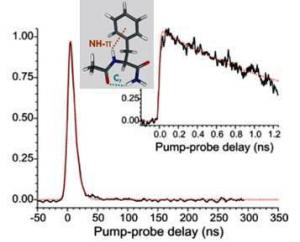


Pump-probe signal obtained after pumping the origin of NAPA B with nanosecond lasers and in the inset at a picosecond time scale.
This important issue for biomolecules deals with the relationship between structure (conformation, environment), and dynamics (reactivity, relaxation). This topic is directly connected to the properties of proteins, following electronic excitation consecutive to a near UV photon absorption. Long-lived excited states are indeed potentially harmfull, since they provide opportunity for photochemistry to take place before the molecule relaxes its energy, leading to structural damages potentially affecting the function of the biomolecule. However, it has been suggested from both experimental hints and theoretical evidences that in biomolecules ultrafast relaxation phenomena can take place, allowing them to bypassing damaging photochemical phenomena. This aim of the present work is specifically to document the basic phenomena controlling the lifetime of the excited states, through
- An experimental characterization of the lifetimes, in pump-probe experiments at several timescales (nano-, pico-or femtosecond), and of the nature of the electronic states formed,
- A theoretical modeling of the processes involved, in particular the role of conical intersections among the several electronic states involved.
Time-resolved experiments performed in the nanosecond or picosecond (Collaboration with CLUPS, UPSud), are naturally conformer-selective thanks to their limited spectral width. However, this is no longer the case in the femtosecond (LUCA laser, SPAM / SLIC) where an additional conformer-selective process must be introduced. The « DIRCOS » project, for « Infra-Red Diagnostics for a COnformation-Selective femtochemistry », funded by the LabEx PALM (2013 Call), aims at developing a new probe technique based on the combination of nanosecond IR excitation and pump-probe femtochemistry.
The theoretical approach of the excited state dynamics will be treated by quantum chemistry, which represents a real challenge for that discipline. It is conducted through a dual strategy combining nonadiabatic methods and more sophisticated quantum chemistry methods.
Our recent results about the excited state dynamics of Phenylalanine-containing peptides have been published in the Journal of the American Chemical Society.
•  Laser-matter interaction › Physico-chemistry and Chemical-physics
Laser-matter interaction › Physico-chemistry and Chemical-physics  Physics and chemistry for life sciences and the environment › Physics and life
Physics and chemistry for life sciences and the environment › Physics and life
• Interactions, Dynamics and Lasers Laboratory (LIDYL) - CEA-CNRS and Paris Saclay University • Service des Photons Atomes et Molécules
• Group "BioMolecular Structures" • Laboratoire Francis Perrin











